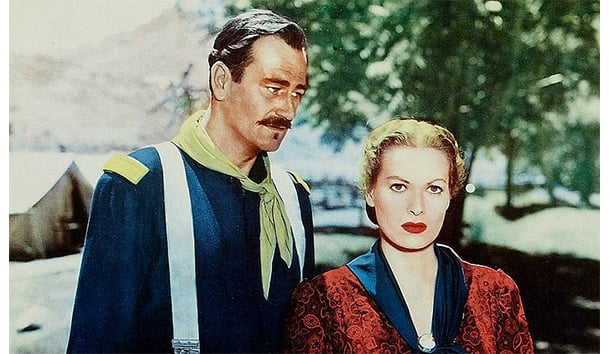In 1979, as John Wayne was dying, his friend and costar in five movies, Maureen O’Hara, went to Capitol Hill to urge Congress to issue a medal honoring Wayne. She told Congress that, “To the people of the world, John Wayne is not just an actor—and a very fine actor—John Wayne is the United States of America.” O’Hara also asked that the medal bear this simple inscription: “John Wayne, American.” Wayne was well-known to be a partisan Republican, and the Democrats controlled both houses of Congress and the White House, but Congress was no more able to ignore O’Hara than Wayne’s Sean Thornton had been able to ignore O’Hara’s Mary Kate Danaher in their most memorable collaboration, The Quiet Man. The bill honoring Wayne passed the Senate by voice vote, passed the House unanimously, and was signed into law by Jimmy Carter, with the medal bearing the inscription requested by O’Hara.
O’Hara had plenty of support, of course, from figures as diverse as General of the Army Omar Bradley, Frank Sinatra, and Hollywood liberals Gregory Peck and Katherine Hepburn. And Wayne’s greatness was also recognized by another liberal, film critic Roger Ebert, who wrote in 1979 that Wayne “brought life to his bad movies and greatness to his good ones.” Ebert observed that Wayne became a great actor
because he went out into Monument Valley a great many times with a man named John Ford, and they made some of the greatest American movies of all time without giving it much more thought than the whisky and the poker games and the campfires with which they occupied their evenings.
What a difference a cultural revolution makes. In February 2019, a screenwriter named Matt Williams read an interview Wayne gave Playboy in 1971 and tweeted, “Jesus f–k, John Wayne was a straight up piece of shit.” Thousands of other ignorant leftists immediately howled their approval, and soon the Los Angeles Times’ Michael Hiltzik was arguing that the interview revealed Wayne to be an “outspoken racist and homophobe,” thereby “undermin[ing] any justification for his name and image to adorn a civic facility.” Thus, Hiltzik argued that Wayne’s name should be removed from the Orange County Airport and his statue in that airport should come down, presumably to be replaced by the image of a Californian more in tune with the sensibilities of today’s Golden State, such as Maxine Waters or Caitlyn Jenner. Hiltzik did allow, though, that Wayne’s deplorableness “doesn’t necessarily mean that it’s impossible or immoral to enjoy westerns and war movies starring John Wayne; that’s a personal choice.”
The attack on Wayne confirmed the foresight of Sam Francis, who repeatedly argued in these pages that the attack on Confederate monuments and symbols would soon be followed by a general assault on monuments honoring virtually any Western figure predating the 1960’s. The relentless message of the Cultural Marxists is that the past is a dark place, marked by pervasive oppression by nefarious white males. It is because of the danger it poses to that message that Hiltzik’s grudging concession that consenting adults be allowed to watch John Wayne movies in the privacy of their homes may prove to be unwise.
Unwise because Wayne created numerous memorable characters and enlivened many memorable movies, from Stagecoach’s Ringo Kid in 1939 to True Grit’s Rooster Cogburn in 1969 and beyond. Those who watch the movies made by Wayne and his contemporaries during that Golden Age of American Cinema will encounter both genuine historical artifacts unmediated by Cultural Marxism and, in many cases, stories about the past far different from the ones Cultural Marxists tell. This exposure may prove intellectually liberating, since it will show, in vivid and striking images, that there was more to the past than oppression and that there are other ways of looking at the world than the perspective of today’s progressives. Old movies also introduce viewers to a superior popular culture. The recent passing of Stanley Donen, the director of Singin’ in the Rain, at the same time that Hollywood was gathering to give Oscars to a bevy of forgettable films, brought this point home; 1952 saw John Ford’s The Quiet Man and Fred Zinnemann’s High Noon in addition to Donen’s masterpiece. When was the last year Hollywood produced three movies of that caliber? Or even one?
The recognition that the past is not what the Cultural Marxists say it was does not necessarily lead to conservatism. But it might. Sam Francis often expressed his admiration for what he saw as the profound conservatism of two of the films John Ford and John Wayne collaborated on, The Searchers and The Man Who Shot Liberty Valance. By leaving a crack in the door to the past, Hiltzik unwittingly exposes the Achilles heel of Cultural Marxism. Forget FOX News. Turner Classic Movies is the television channel to watch.



Leave a Reply